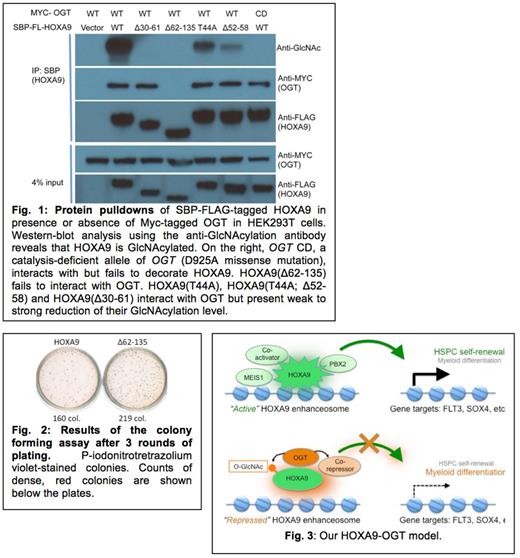Abstract
HOXA9 helps maintain the balance between hematopoietic stem/progenitor cell self-renewal and myeloid/lymphoid cell differentiation in the bone marrow (BM). HOXA9 encodes a homeodomain-containing transcription factor, which mediates its function in collaboration with other co-factors, e.g., MEIS1. Several genetic alterations observed in acute myeloid leukemia (AML) patients, e.g., chromosomal translocations involving the MLL gene, are associated with aberrant upregulation of HOXA9, thus disrupting the hematopoietic balance towards leukemogenesis.
In a proteomic screen combining the use of affinity purification coupled to mass spectrometry analysis (AP-MS) and the yeast two-hybrid system (Y2H), we discovered that HOXA9 interacts physically with OGT, an O-linked N-acetyl glucosamine transferase. We have obtained multiple lines of evidence supporting the HOXA9-OGT interaction: i) Y2H; ii) identification of endogenous OGT by affinity purification using HOXA9 as a bait in both murine leukemic blasts and human THP1 AML cells; and iii) reciprocal protein pulldowns in HEK293T cells (Fig. 1). A domain mapping analysis revealed that the HOXA9 domain D62-135 is required for the OGT-HOXA9 interaction. We also demonstrated that the MEIS interaction motif of HOXA9 is GlcNAcylated by OGT. We used a colony forming assay to measure the clonogenic potential of the OGT-interaction defective allele of HOXA9, i.e., HOXA9(Δ62-135). We observed a higher number of colonies for HOXA9(Δ62-135) in comparison to WT HOXA9 (Fig. 2). In light of these results, we hypothesize that the HOXA9-OGT interaction has an inhibitory effect on HOXA9's ability to promote colony formation. This model is also corroborated by an experiment in which co-transduction of OGT with HOXA9 inhibits clonogenesis, further supporting the hypothesis that the OGT has a suppressive effect on HOXA9.
By quantitative RT-PCR, we show that the level of expression of FLT3, a well-characterized target of HOXA9, is higher in HOXA9(Δ62-135)-transduced BM cells than in HOXA9-transduced ones. To identify genes modulated by HOXA9 in an OGT-dependent manner, we analyzed the transcriptome of HOXA9(Δ62-135)-transduced BM cells by expression profiling studies using next-generation sequencing (RNA-seq). We identified 1,083 and 551 genes that are further up- or further down-regulated with HOXA9(Δ62-135) in comparison to HOXA9. Increased chromatin binding of HOXA9(Δ62-135) at the loci of some of these genes was also confirmed by chromatin immunoprecipitation followed by qPCR (ChIP-qPCR). We note that pro-oncogenic genes such as FLT3, LCK and ERG, which have been previously characterized as being HOXA9-upregulated, demonstrate even higher levels of expression in cells transformed by HOXA9(Δ62-135). The most striking observation, though, arose from the integrative analysis of two RNA-seq datasets [HOXA9 and HOXA9(Δ62-135)-transformed BM cells] and two ChIP-seq datasets (HOXA9 and OGT ChIP-seq in BM cells). Remarkably, we observed that HOXA9-downregulated genes that are further downregulated in presence of HOXA9(Δ62-135) (N = 82) are specifically enriched for OGT-bound genes (N = 41 out of 82; P < 4 x 10-10). In contrast, such enrichment is not observed for HOXA9-upregulated genes (N = 22 OGT-bound genes out of 108 HOXA9/HOXA9(Δ62-135)-upregulated genes; no statistical enrichment). Thus, our transcriptome-wide analysis of the OGT-dependent regulation of HOXA9 gene targets highlights the critical importance of HOXA9 as a negative regulator of transcription, rather than a positive regulator. This observation is further validated by the analysis of gene expression profiles in human leukemia samples. Indeed, a larger than expected number of the human orthologs of the murine HOXA9-downregulated genes have a low level of expression in MLL translocation-driven AML patient samples compared normal samples. In comparison, such trend is not as prevalent for the human orthologs of the murine HOXA9-upregulated genes.
In conclusion, our data support a model in which OGT inhibits HOXA9's ability to transform primary bone marrow cells, thus defining OGT as a potential tumor suppressor of HOXA9-driven AML. The biomedical relevance of the OGT-HOXA9 interaction to HOXA9-driven leukemogenesis is being investigated in vivo using a HOXA9-induced mouse model of AML. This project is supported by the WES Foundation and the American Society of Hematology.
No relevant conflicts of interest to declare.
Author notes
Asterisk with author names denotes non-ASH members.


This feature is available to Subscribers Only
Sign In or Create an Account Close Modal